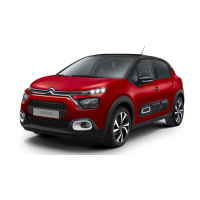100
Practical information
Fuel cut-o
Your vehicle is equipped with a safety device
which cuts o the fuel supply in the event of a
collision.
Misfuel prevention (Diesel)
(Depending on country of sale.)
This mechanical device prevents lling the tank
of a Diesel vehicle with petrol.
Located in the ller neck, the misfuel prevention
device is visible when the ller cap is removed.
Operation
When a petrol ller nozzle is inserted into the
fuel ller neck of a Diesel vehicle, it comes into
contact with the ap. The system remains closed
and prevents lling.
Do not persist but introduce a Diesel type
ller nozzle.
It remains possible to use a fuel jerrycan
to ll the tank.
Travelling abroad
As Diesel fuel pump nozzles may be
dierent in other countries, the presence
of the misfuel prevention device may make
refuelling impossible.
Before travelling abroad, it is advisable to
check with a CITROËN dealer if the vehicle is
suitable for the distribution equipment of the
countries visited.
Compatibility of fuels
Petrol fuels conforming to the EN228 standard
containing up to 5% and 10% ethanol
respectively.
Diesel fuels conforming to the EN590, EN16734
and EN16709 standards and containing up to
7%, 10%, 20% and 30% fatty acid methyl ester
respectively. The use of B20 or B30 fuels, even
occasionally, imposes special maintenance
conditions referred to as "Arduous conditions".
Paranic Diesel fuel conforming to the EN15940
standard.
The use of any other type of (bio) fuel
(vegetable or animal oils, pure or diluted,
domestic fuel, etc.) is strictly prohibited (risk
of damage to the engine and fuel system).
The only fuel additives authorised for use
are those that meet the B715001 (petrol)
or B715000 (Diesel) standards.
Diesel at low temperature
At temperatures below 0 °C (+32 °F), the
formation of parans in summer-type Diesel
fuels could prevent the engine from operating
correctly. In these temperature conditions, use
winter-type Diesel fuel and keep the fuel tank
more than 50 % full.
At temperatures below -15 °C (+5 °F) to avoid
problems starting, it is best to park the vehicle
under shelter (heated garage).
Travelling abroad
Certain fuels could damage your vehicle’s
engine.
In certain countries, the use of a particular
fuel may be required (specic octane rating,
specic trade name, etc.) to ensure correct
operation of the engine.
For all additional information, consult a dealer.
Snow chains
In wintry conditions, snow chains improve
traction as well as the behaviour of the vehicle
when braking.
The snow chains must be tted only to
the front wheels. They must never be
tted to "space-saver" type spare wheels.
Take account of the legislation specic to
each country on the use of snow chains
and the maximum authorised speed.
Use only the chains designed to be tted to the
type of wheel tted to the vehicle:
Original tyre size Chain types
185/65 R15 Maximum 9 mm link
195/65 R15
205/55 R16
205/50 R17 Cannot be tted with
chains
For more information on snow chains, contact a
CITROËN dealer or a qualied workshop.
Installation tips
► To t the chains during a journey, stop the
vehicle on a at surface on the side of the road.
► Apply the parking brake and position any
wheel chocks under the wheels to prevent
movement of the vehicle.

